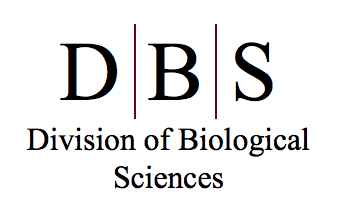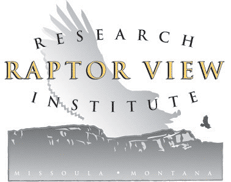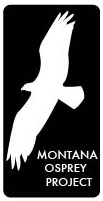
Frequently Asked Questions
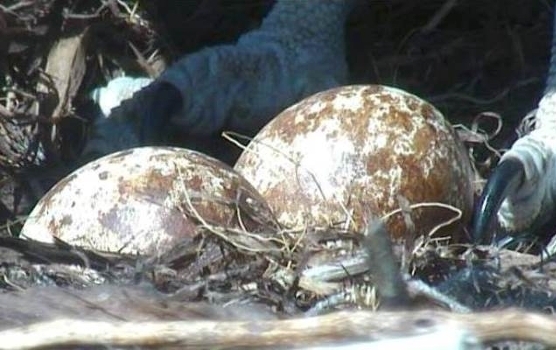
Here are the answers to some frequently asked questions.
FAQ
Banding
Q: What is the risk of banding ospreys?
A: Scientific evidence shows that the risk from banding ospreys is low. Tens of thousands of ospreys have been banded around the world, and many of them have bred successfully for years. We also know that banded populations of ospreys grow as fast as unbanded populations. For example, ospreys (adults and chicks) in Westport, Massachusetts, were intensely banded during the 1980s when the population was recovering from near extinction following heavy DDT use. That population doubled in 6-8 years, which was identical to the population growth of nearby unbanded osprey populations. Photo courtesy of William Munoz.
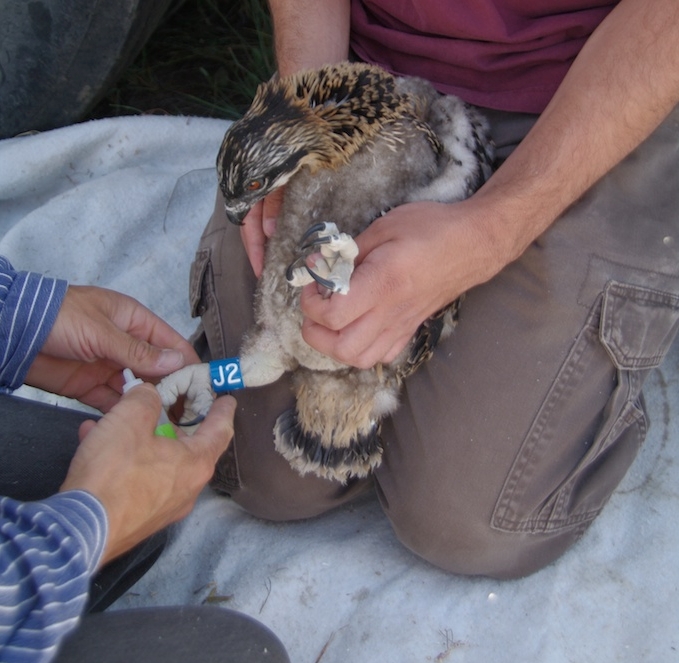
The bands themselves are very light aluminum, and we are especially careful to ensure a good fit and make sure there are no sharp edges. You might think that when the ospreys slam into the water to catch a fish that the impact would jam the band up against their ankle joint and rub it. However, ospreys hit the water with their feet wide open, and this seems to protect their legs. When we and others examine the legs of banded ospreys we do not see any sign of abrasion or irritation of the skin on their legs. We have talked with Dr. Alan Poole and Dr. Rob Bierregaard, two of the leading osprey biologists in North America who have dedicated their lives to osprey conservation, and they have banded ospreys that are now more than 20 years old and who are still going strong.
Q: Aren’t you disturbing the ospreys by banding them?
A: There is no question that the process of banding the birds does disturb them briefly. When we go up to the nests the adults are upset, but after we put the chicks back in the nest, the female is often back with them before we are even back on the ground. The welfare of the osprey chicks is our top concern, and if we feel there is any danger to the young, we will not band them. For example, in 2012 we took three chicks out of a nest in Missoula. We banded one chick, but felt that the chicks were getting more stressed than we like to see. So we halted the operation, did not band the other two chicks and did not take blood samples, but got the chicks back up to their nest immediately. Although we do not like to disturb the ospreys in the short-term, gathering samples and banding them is important in the long-term to gain the scientific understanding needed to improve conditions for their health and survival.
Q: What does banding tell us?
A: Everything we know about several important aspects of osprey biology come from banding studies: sources of mortality, where they migrate, how they disperse, and how long they live. Our studies are now focusing on how very high levels of mercury influence ospreys. We are banding osprey chicks in areas of high mercury and in nearby areas with much lower mercury. Over time, with these careful banding studies and ongoing monitoring, we want to see if there are differences in osprey survival and dispersal that are associated with levels of mercury. There is currently no other way to collect data on this extremely important conservation issue.
Q: Is what you’re doing legal?
A: Yes, but only because we have special permits to band ospreys. First of all, in order to band birds in the United States one has to have a Master Banding Permit issued by the US Fish and Wildlife Service, or operate under the auspices of a Master Bander. These are not easy permits to get--they require an apprenticeship and a clear demonstration that you are a safe bander and that you understand and abide by all the rules and regulations about banding. Beyond the Master Banding Permit, our project also requires specific federal and state permits, as well as nationally overseen Animal Care and Welfare permits. Photo courtesy of Jeremy Roberts and Conservation Media.
Human Intervention
Q: What does intervention mean?
A: Intervention means the researchers step in and work out a problem that occurs with the ospreys on the nest. Rarely does this happen: our basic philosophy is hands off - we cannot micromanage the lives of wildlife. However, we’ll jump in if the problem is immediate and human-caused, like embedded fish hooks, osprey chicks tangled up in baling twine, etc. The main motivation for our research is to figure out ways to make the breeding environment as safe as possible for all ospreys in this part of the world so that osprey populations can thrive on their own.
Q: Why don’t you intervene with the ospreys?
A: Ospreys are wild birds - they are not pets, and this is not a Disney movie. What we have set out to do with the cams is allow you a very intimate view of the trials and tribulations of two osprey families. What comes with this is the good and sometimes the sad.
As you have all gathered by watching, learning to be an osprey is extremely hard and takes a long time. To put things in perspective, it is estimated that about 50-60% of all osprey chicks do not survive their first year of life. However, if they do survive their first year and figure out how to fish well on their own, their survival rates shoot up to as high as 85-90% per year after that. Since ospreys can live 15-20 years (still some breeding older than 25 years), a pair only has to produce two chicks that survive to breed on their own to replace them and maintain a stable population. Osprey populations can increase rapidly in some places, which indicates that those populations are producing many more chicks that survive than just the stable replacement level.
Q: Watching the cams is difficult right now, shouldn’t you intervene?
Not unless it’s a human-caused emergency. If you find watching the cams too upsetting, we are sorry and suggest that you stop watching. It is at our discretion to turn off the cams if the situation is really hard to see. Just keep the big picture in mind and remember that ospreys are adapted to a tough life and they are incredible birds. Enjoy the many happy moments and think positive thoughts during the rough spots.
Permits
Q: What permits do you have?
A: In order to go up to the nest, band chicks and do our research, we have several permits: a Master Banding Permit issued by the US Fish and Wildlife Service, specific federal and state permits to research raptors, as well as nationally overseen Animal Care and Welfare permits.
Q: Why do you need permits?
We started this project because we care deeply and passionately about ospreys, and it is important to us that they are protected. The good news about ospreys is that they are probably the most tolerant of all raptors. Every day that you watch them on our nest camera think about where they are – basically in a parking lot beside a busy highway and a major train track! Their flexibility and tolerance of human activities is one of the reasons that ospreys are found in so many places and on every continent except Antarctica.
We are very careful to make sure that all of our research is conducted at the highest ethical standard, and that it is all done with the proper permits. Every year we make sure we have the proper Federal, State, local, and animal care permits. When we disturb them, we are always asking ourselves “What is the least invasive and disruptive way to do this?” “What is the safest way to do this?” “Do we really need to do this?” We really do everything to keep the disturbance to a minimum.
Education
Q: How do you use your research to educate people and reach out to the public?
A: We started this osprey project since we care deeply and passionately about them. We spend a lot of our time, effort and money on educating the public and politicians about the important issues that we learn from the ospreys. The majority of our funding comes from the Natural Resource Damage Program to support our education and outreach efforts.
During the last several years, we have brought along almost 1,000 people to enjoy ospreys up close and personal when we band them, not to mention the thousands that watch the cams. We especially love bringing kids out to the nests, and we work with many school and camp groups during the spring and summer. Teaching isn’t a one-way street, and we’re often inspired by the people who come out with us. Here's Erick with a group of kids handling an osprey chick.
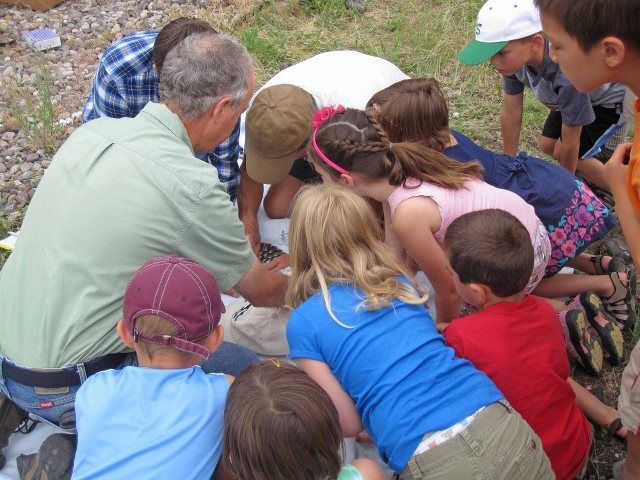
Baling Twine
Q: Why is baling twine a problem?
It is estimated that 10% of osprey chicks die in their nests after getting tangled up in baling twine that was brought in as nesting material by their parents. Many nests in our area contain large amounts of the deadly twine, and we have removed lots of it during our nest visits. The photograph below shows an osprey nestling that we were able to save. The tangled twine around its legs would have cut off circulation and killed it, which was the case with the chick in the following picture. Photos courtesy of William Munoz.
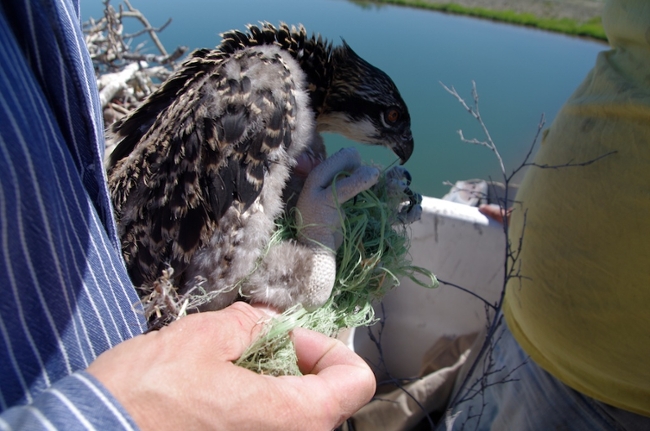
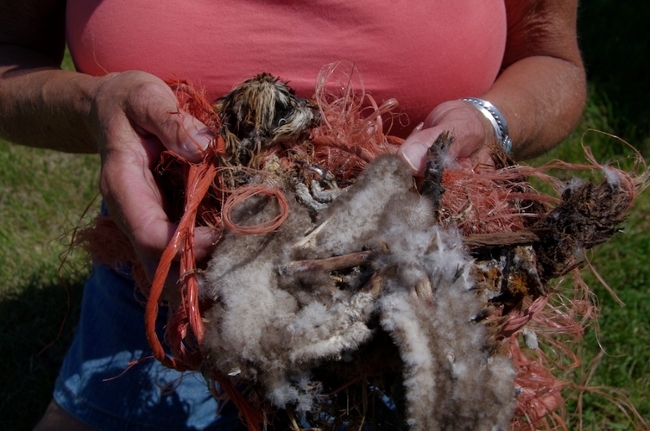
Q: What can be done about baling twine?
In an effort to educate the ranching community about the detrimental effects of baling twine, Erick Greene, together with two Missoula high school students, Matt Parker and Max Eggenhoff, developed a brochure for distribution to interested members of the public. Please feel free to download the PDF file.
Funding
Q: How is this project funded?
A: Our project is funded by the Montana Natural Resources Damage Program and the Cornell Lab of Ornithology, with additional support from the University of Montana, Raptor View Research Institute, Riverside Health Center, Raptors of the Rockies and several small grants.
Donations make a huge difference to our project and help keep the cams running. Please see our donate page.
